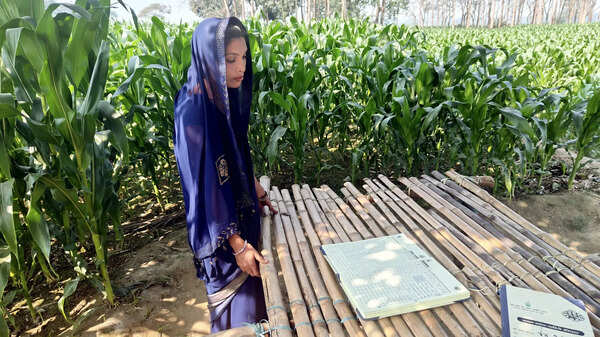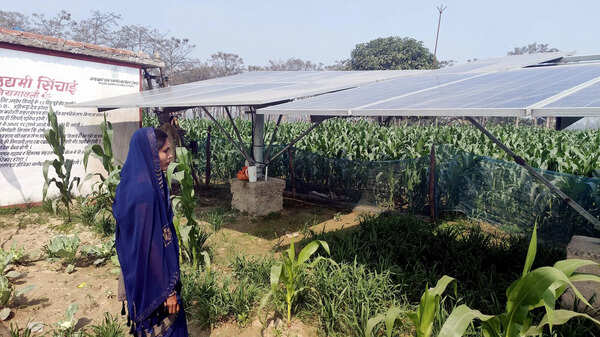NEW DELHI: Indu Devi, a 35-year-old widow from Suryahi village, has known hardship all too well. After her husband was hanged over a land dispute, she was left with little more than a small patch of land and mounting debts. Survival seemed uncertain—until she discovered solar-powered irrigation.

Indu Devi near her solar pump in Suryahi village
Initially hesitant, unsure of how she, with no technical know-how, could operate a pump, she decided to take the leap. Today, she earns a stable income by supplying water to neighboring farms.
“It’s just a switch on and off. But it has given me a way to survive,” she said.
Indu’s story is inspiring, but she is not alone. Across Bihar, women farmers, many as part of self-help groups (SHGs), are investing in solar irrigation, transforming their fields and futures.

<p>Indu Devi looks at her solar pump (PTI Photo)<br></p>
From struggle to sustainability
For years, irrigation has been a challenge in Bihar. Farmers have battled erratic rainfall, scorching summers, and unreliable electricity. Diesel pumps, once the primary solution, were expensive and inefficient, leaving smallholders—especially women—struggling.
“The introduction of solar-powered irrigation pumps has changed the game. These pumps, operated by women, provide water at a fraction of the cost, ensuring that even the smallest plots of land can flourish,” said Mukesh Chandra, a team leader at Aga Khan Rural Support Programme, which has facilitated the installation of these pumps in Muzaffarpur.
Breaking barriers, one pump at a time
For many women, stepping outside their homes was the first battle.
Devki Devi, a mother of three from Kakrachak, faced resistance from her husband, an alcoholic who initially forbade her from attending SHG meetings.
“He didn’t let me leave the house for the SHG meetings. But when I told him about the income we could earn, he finally agreed,” she recalled.
With a loan of Rs 1.5 lakh at 10% interest, she installed a 5 HP solar pump in July 2023. Now, she supplies water to 12 farms, charging Rs 229 per acre—far less than diesel alternatives. Within months, she covered her family’s expenses and even managed to save.
However, social hurdles remain.
Sita Devi and Rashmi Kumari, among others, have faced opposition from their families and communities.
“Patriarchy still beats us,” said Sangita, who was forced to hand over her earnings to her husband.
Overcoming financial and technical Hurdles
The upfront cost of solar pumps is another barrier. Women from marginalized backgrounds struggle to arrange the necessary funds.
Sangita Devi, 75, from Karanpur, had just enough land to install a solar pump. With her children grown and gone, she had no source of income. To make it work, she borrowed Rs 2.5 lakh from her village SHG.
Now, she supplies water to nearby farms and dreams of upgrading her thatched hut into a pucca home.
“Right now, I am paying back the loan but soon…,” she said.
Maintenance is another challenge. While the pumps are easy to operate, keeping the solar panels clean and functioning requires regular effort. Many women have stepped up, learning the basics and training others in their communities, said Chandra.
The ripple effect
Despite the obstacles, these women have proved their resilience. The shift to solar irrigation has slashed irrigation costs—by as much as 50% in some cases—allowing farmers to invest in better seeds, fertilizers, and agricultural inputs. The result? Higher yields, improved food security, and rising incomes.
But the impact extends beyond irrigation.
Women are now branching out—setting up flour mills, running rice mills, and exploring new solar-powered ventures. The money saved on irrigation is funding children’s education, clearing debts, and even helping families plan for weddings.
In Bihar’s villages, where the sun once symbolised hardship, it now represents hope. For these women, solar energy is not just powering fields—it’s illuminating futures.
(With inputs from PTI)










